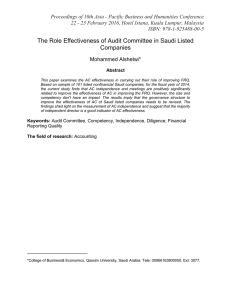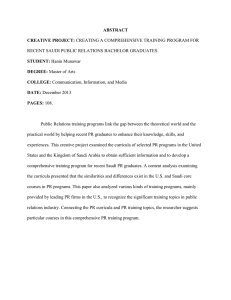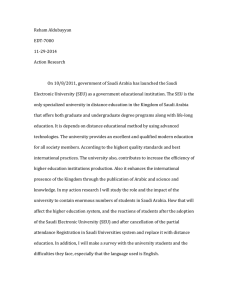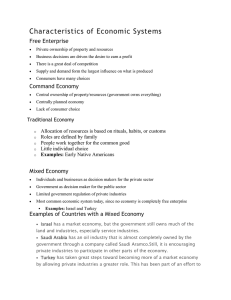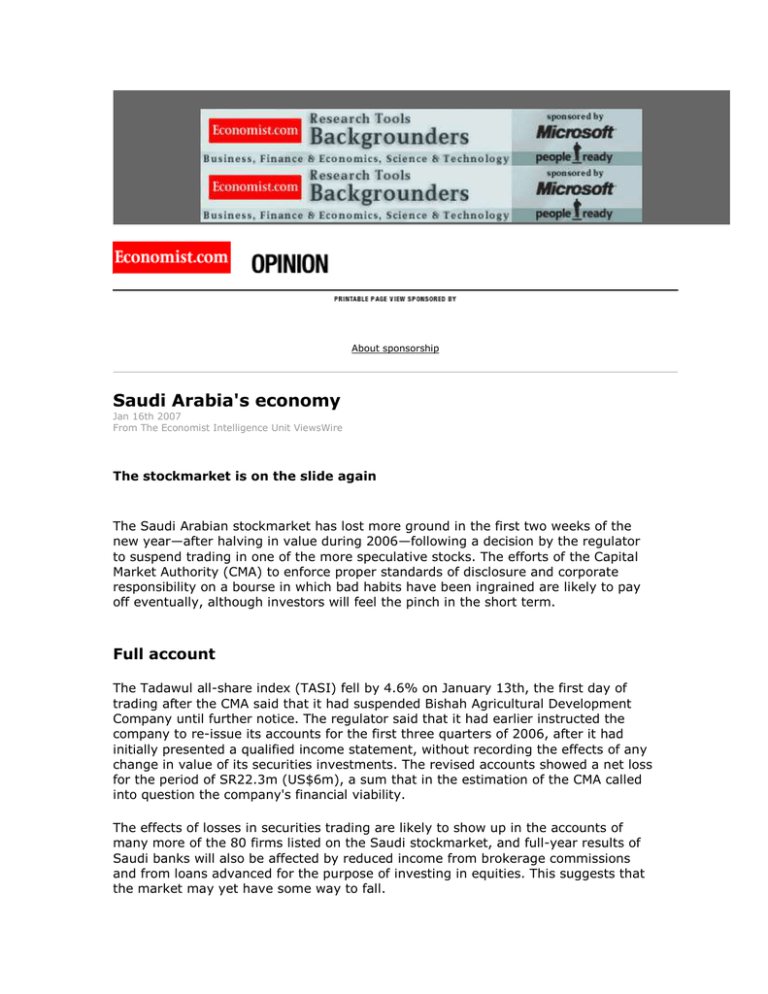
About sponsorship
Saudi Arabia's economy
Jan 16th 2007
From The Economist Intelligence Unit ViewsWire
The stockmarket is on the slide again
The Saudi Arabian stockmarket has lost more ground in the first two weeks of the
new year—after halving in value during 2006—following a decision by the regulator
to suspend trading in one of the more speculative stocks. The efforts of the Capital
Market Authority (CMA) to enforce proper standards of disclosure and corporate
responsibility on a bourse in which bad habits have been ingrained are likely to pay
off eventually, although investors will feel the pinch in the short term.
Full account
The Tadawul all-share index (TASI) fell by 4.6% on January 13th, the first day of
trading after the CMA said that it had suspended Bishah Agricultural Development
Company until further notice. The regulator said that it had earlier instructed the
company to re-issue its accounts for the first three quarters of 2006, after it had
initially presented a qualified income statement, without recording the effects of any
change in value of its securities investments. The revised accounts showed a net loss
for the period of SR22.3m (US$6m), a sum that in the estimation of the CMA called
into question the company's financial viability.
The effects of losses in securities trading are likely to show up in the accounts of
many more of the 80 firms listed on the Saudi stockmarket, and full-year results of
Saudi banks will also be affected by reduced income from brokerage commissions
and from loans advanced for the purpose of investing in equities. This suggests that
the market may yet have some way to fall.
The TASI bottomed out at 7,029 points on January 14th, its lowest level in 27
months, before staging a weak rally. The market is already 11% down since the end
of 2006, and the index is almost 70% below its record level of 20,967 on February
25th 2006. Market capitalisation fell by 50% during 2006 to the SR1.22trn
(US$326bn), the equivalent of 96% of GDP.
Playing by the rules
The initial adjustment of the market in March 2006 was in part a reaction to the
unwarranted exuberance that had pushed share prices up to levels that bore little
relation to their underlying value. However, it also reflected the resistance of
powerful traders to the tighter standards being demanded by the CMA. One of the
peculiarities of the Saudi stockmarket is that while electronic trading was introduced
in the early 1990s it was not until 2004 that the CMA was established to operate as a
dedicated regulatory authority, with the power to enforce its own rules. The CMA
devoted much of its energy in its early days to stamping out insider trading, which
was rife under the previous system of light regulation. It has now shown its teeth in
the matter of corporate disclosure.
If standards of governance are improved, the Saudi market will have a better chance
of attracting serious, long-term investors--trading has hitherto been dominated by
retail investors, who have tended to base their decisions on short-term price
movements rather than on careful evaluation of company performance and
prospects. The market is also set to benefit from the start of operations by newly
licensed brokerage, advisory and asset management firms, including several
prominent international and regional names, such as HSBC and EFG-Hermes.
At present direct trading in Saudi stocks is restricted to Saudis, citizens of the other
five Gulf Co-operation Council member states and, since a decree issued last year,
foreigners resident in the kingdom. It is also possible for foreigners to invest
indirectly through mutual funds. Once the supply of tradable securities is increased
(many of the largest stocks are still majority state-owned) the Saudi government is
expected to open the door wider for foreign investment in the market. The average
price/earnings ratio has fallen to about 14, which could be attractive for new
investors given the strong underlying performance of the Saudi economy.
IPOs
The fall in equities prices has failed to halt the stream of initial public offerings (IPOs)
on the Saudi market, which have been associated with privatisation—both in the
sense of selling state holdings and of opening up previously restricted areas of the
economy—as well as with the growing financing needs of existing private companies.
The CMA has recently approved plans for the first IPOs by a batch of 13 new
insurance companies that were established last year. Malaz Co-operative Insurance
and Re-insurance Company will offer 14.24m shares, representing 47.5% of its
capital, between February 3rd-12th, and Medgulf Co-operative Insurance and Reinsurance Company will follow suit between February 17th-26th with an offering of
20m shares, amounting to 25% of its capital. The shares will be priced at par of
SR10 (US$2.67) each. The CMA has also approved plans by Saudi Industrial
Investment Group to raise SR2.1bn in new capital through issuing new shares, half
to existing shareholders and the remainder through a public offering. The proceeds
will contribute to the financing of the group's third petrochemical project, being
carried out (like the previous two) in partnership with ChevronPhillips Corporation of
the US.
Later this year IPOs are expected to be launched by the consortia that win new
mobile and fixed telecoms licences, for which bids are due by respective deadlines of
February 24th and March 10th.
Copyright © 2007 The Economist Newspaper and The Economist Group. All rights reserved.


